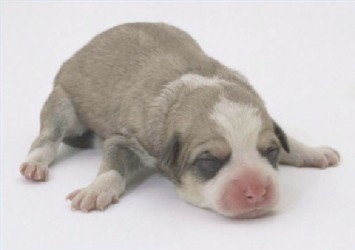I might have mentioned before that, unlike a human foetus, which is usually only one by itself in the womb surrounded by its own thin covering membrane (the amniotic sac), the each of the several puppies in a bitch’s womb is surrounded by its own enveloping bag.
When each pup is born, its surrounding sac is ruptured and the puppy is set free to breathe on its own. If this does not occur, 

Some textbooks describe an alternative method that can be used to clear away the threatening fluid in the nostrils. They advise that the puppy be held in your hands in such a way that the head is supported while affording you the opportunity of swinging the pup downwards, stopping abruptly when its nose is pointing to the floor. The centrifugal force created expels the fluid from the nostrils. I am just a little fearful of this method, because owners are usually a bit flustered during the birth process, and the puppy is slippery. It could be fatal, if the pup slips from your grasp and falls to the floor with the force of the swing.
Once the pup is freed from the membrane and from the fluid in its nostrils, it should be presented to the mother to lick, sniff, cuddle and massage. If she doesn’t seem interested in the pup, you must take a soft cloth and do the cleansing and massaging. Then place the puppy onto the nipple, which you would have gently squeezed to ensure a droplet of milk oozes on to the surface. The pup should begin the suckling reflex immediately, if the mother doesn’t reject her offspring.
Sometimes, after a difficult delivery, a puppy may be too weak or too flaccid to breathe on its own. Squeeze the chest gently from side to side and then from front to back. If the puppy still will not breathe, place your mouth over his mouth and nostrils and breathe gently until you see his chest expand. Do not exhale too forcefully as this can rupture his lungs. Then remove your mouth to allow the puppy to exhale. Repeat this several times until the puppy is breathing and crying. Place him/her on the bitch’s nipple. Once the pup starts suckling on his own, we can hope for steady improvement.
We’ll continue with this theme next week.
Please implement disease preventative measures (vaccinations, routine dewormings, monthly anti-heartworm medication, etc) and adopt-a-pet from the GSPCA’s Animal Clinic and Shelter at Robb Street and Orange Walk, if you have the wherewithal to care well for the animals. Do not stray your unwanted pets, take them to the GSPCA’s Clinic and Shelter instead. If you do not wish your pet to have puppies or kittens, you may exploit the GSPCA’s free spay and neutering programme. If you see anyone being cruel to an animal, or if you need any technical information, please get in touch with the Clinic and Shelter by calling 226-4237.





